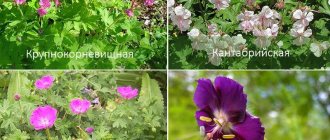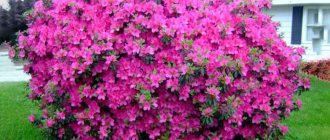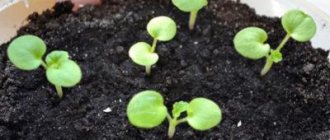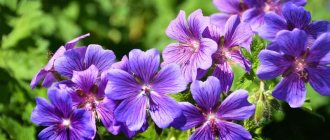A beautiful subshrub with the unusual name camellia, brought to Russia from Japan and the tropical Philippines, looks elegant at any time of the year. The bushes that bloom all season long do not shed their leaves even in winter, they look a little like roses, and vaguely resemble peonies. Regal camellia garden, planting and caring for which in open ground requires special attention, is considered a capricious plant among gardeners. But if certain growing rules are observed, it pleases the owners with lush flowering, delicate aroma and decorative appearance.
Description of the plant
Garden camellia (cameo) is an evergreen flowering subshrub that came to Europe from Japan, China and Korea, where it grows right on the edges of rivers and forests. It gained popularity among landscape designers due to its glossy dark green leaves with pointed ends and large flowers of soft pink, white and purple color. Under natural conditions, bush camellia blooms in winter, when temperatures reach 12°C. Moreover, the buds cover the branches for 2-3 months, sometimes longer.
With proper care, a shrub or tree grows up to 3-10 m, producing flowers with a diameter of 5-13 cm. Each opened bud has 5 petals and many stamens, and does not fall from the branch for a month.
On a note. Camellia is usually grown in the garden only by residents of warm regions, since the tree is quite heat-loving, even hybrid frost-resistant varieties cannot withstand frosts below 20°C. However, if you wish, you can bring the bushes planted in tubs or flowerpots into greenhouses and sheds in the fall and carefully cover them for the winter.
In landscape design, evergreen bushes are used for landscaping and creating unusual garden or park compositions. They are planted both individually and in groups. The garden Japanese camellia, which grows up to 10 m and produces single buds on the tops and axils of the branches, is especially valued by designers. The flowering of this interesting variety is shown in the photo below.
Combinations with other plants, or impeccable landscape design
Camellia will look great with any flowers, shrubs and even trees in the garden, harmonizing with the rich green hue of the foliage and striking with the beauty of large flowers at a time when flowering is no longer typical for many. The only condition is the acidity of the soil, which is difficult to achieve in mass plantings.
The solution is to grow camellias in a tub, which can not only be placed anywhere in the garden, but also brought indoors during frosts, for example. However, in this case it is worth feeding the plant more often and monitoring the condition of the foliage.
The camellia decorating your territory will please everyone, both guests and household members. All that remains is to install the swing nearby and enjoy the beauty and aroma of flowers!
Types, varieties
Amateur gardeners and breeders have developed many varieties of garden camellia, numbering about 1000 varieties in the form of subshrubs, bushes, trees of different sizes with simple, semi-double and double flowers of different diameters. However, only 3 types are considered the main ones.
- Mountain (Miyagi). It is a shrub up to 3 m high with dark green ovoid leaves, glossy on the outside, with pubescence at the bottom. The leaves have grooves along the edges and reach a length of 3-5 cm. Flowers with a diameter of about 7 cm are distinguished by their delicate color, tinged with pink, white or reddish. They can be collected in 2-3 buds or bloom singly. Camellia Miyagi blooms from November to January-February.
- Japanese. It often grows as a shrub, but it can also be tree-like, reaching a height of 11-13 m. It has ovoid glossy leaves, sometimes taking the shape of an ellipse, pointed at the edges. Small or large flowers with a diameter of 4 to 12 cm can be collected in groups of 3-4 or bloom singly, delighting the owner with their appearance from December to March.
- Chinese (tea bush). It is an evergreen shrub with erect branches. The leaves of the tea bush are oval-elongated, alternate, dark green, 6-7 cm long. Below they are lighter in color. The fragrant flowers are solitary, appear in August, do not fall until late autumn, and are located in the axils of the leaves. The fruits are woody capsules.
Thanks to the development of frost-resistant, winter-hardy varieties of Japanese camellia, the crop can be grown as a perennial plant in open ground. The most popular hybrids that bloom in spring are the following:
- “Hagoromo” is a shrub with a dense crown and elongated branches, all spring covered with chameleon flowers that change shade from pearl pink to white;
- “Freedom Bell” is an upright tree with dense branches, having red flowers with a delicate coral tint, which tolerates pruning well;
- "Donation" is a slow-growing ornamental shrub with purple-pink flowers with a diameter of 10 cm;
- "Debbie" is a fast-growing species with small semi-double buds of pink-purple color;
- “General Colletti” is a hybrid with variegated flowers of a bright red hue, with white and scarlet streaks on the petals.
In the photo below you can see how different varieties of camellia bloom.
Camellia japonica
Adolphe Audusson
Giardino Schmitz
Origin and appearance of the plant
This aristocratic flower came to Russia from Japan and China. In these countries, camellia is used not only to decorate plots of land. The petals of its flowers, added to tea, give it an exquisite aroma and taste.
Camellia japonica flowers
Camellia is a perennial shrub or tree that belongs to the ornamental evergreens. It belongs to the Tea family. There are more than 200 varieties of this shrub in the world.
The 3 main varieties that are grown in central and northern Russia include:
- Oilseed;
- Mountain;
- Japanese.
Camellia oleifera reaches a height of 10 m. Basically, this species is not common in Russia. More often it can be found in forests located near water bodies.
Mountain camellia grows no more than 5 m in height. Most often it is a bush growing on mountain plateaus. It is distinguished by flowers of simple shape.
Camellia oleifera
The Japanese camellia bush reaches a height of about 2 m. It is from this species that many hybrids have been bred. One of the popular hybrids is Camellia Williams. It is adapted to low air temperatures. Its distinctive feature is the dropping of withered buds from the branches. No other varieties shed color on their own.
Description of the flower of the plant
Flowers of different varieties have different diameters. You can grow a camellia with flowers whose diameter is 1 cm, or a camellia whose flower diameter can reach 12 cm. In most cases, the size of the flower depends on the variety.
Even when purchasing seedlings of varieties distinguished by large flowers, you may not see them on the branches of the plant. This can be caused by improper care of the plant, as well as an inappropriate planting location.
Interesting! Camellia shrub is distinguished by a variety of colors. In nature you can find white camellia, red, pink, orange, variegated, etc.
The flowers are located singly on the branches of the plant. There is no aroma. The petals are dense, with oval edges, double, semi-double and single.
Winter hardiness of garden camellias
Winter-hardy camellia varieties have been developed relatively recently. The plant came to Europe in 1738; in Russia it became possible to grow it closer to the middle of the twentieth century.
Selection of location and conditions of detention
Planting camellias and caring for them in the garden may seem quite difficult to some, because the perennial flower requires proper wintering and does not tolerate severe frosts or close proximity to groundwater. In what conditions should the beautiful cameo be grown?
- Lighting and location. The plant loves diffused sunlight, but the bright rays of the sun are unpleasant for it and can cause burns to leaves and buds. The best option for planting is the western or eastern part of the garden, where there is no wind and strong shade. It is better to plant seedlings on a hill, along fences or walls of a house.
- Temperature. Modern frost-resistant varieties can withstand frosts of 15-20°C in winter. However, in central Russia, bushes require shelter with non-woven material and spruce branches, otherwise the branches with roots will die during prolonged cold weather. In pots, plants can overwinter at temperatures of minus 10-15°C.
- Air and humidity. The bushes do not tolerate strong gusts of wind and drafts, so it is worth providing protection from them throughout the year. In spring and summer it is also necessary to protect crops from drought and overwatering.
- Priming. Cameo prefers to grow in acidic soil. If you use a purchased soil mixture for growing in a tub, the composition for rhododendrons or azaleas is suitable. If the soil is prepared independently, peat, sand, pine litter, humus and perlite are mixed in equal parts. Be sure to add a drainage layer of expanded clay, fine gravel or pebbles to the bottom of the planting hole.
Selecting the required soil mixture
The main secret to successfully growing camellia bushes is the correct selection of soil composition. In addition, the soil must be constantly kept sufficiently moist and a good drainage system provided. These conditions can be achieved by adding organic fertilizers to the soil in sufficiently large quantities, a layer of gravel or sand. The delicate petals of camellia are very similar to wax.
To improve a garden plot or plant camellias in a container, it is necessary to use acidic soil, which contains:
- Sand or crushed tree bark;
- Vermiculite, perlite;
- Peat.
Thanks to this soil composition, the plant’s roots receive even moisture, the moisture does not have time to stagnate, and the soil will be easily saturated with oxygen.
Chinese camellia is successfully used for food purposes - aromatic tea is brewed from its petals.
When to plant
Camellia seedlings are planted in open ground in April, around 15-20. Planting is completed on the tenth of June. They dig up a bed or flowerbed in advance, adding complex compounds in the form of granules. The process of planting from a container into street soil consists of several steps.
- Carefully remove the seedling from the pot, being careful not to damage the fragile roots.
- Place the cutting in the hole where the training material and a layer of nutrient soil have already been poured.
- Sprinkle the roots with soil without deepening the root collar.
- Compact the soil with your palms, water and mulch with sawdust and humus.
- The first week is shaded from direct sunlight, then watered regularly.
What it is?
It is curious that camellia is almost certainly present in your home, even if you do not suspect it: the fact is that the ordinary tea bush is also a variety of this flower. Of course, camellia is not just one species, and far from ordinary tea is grown as a houseplant, but in general it is also precisely camellia. The name of the plant was given by Carl Linnaeus himself, the author of the world's first systematic classification of biological species of animals and plants.
Camellia was named after the Czech missionary and scientist Georg Joseph Kamel, who is believed to have brought ornamental shrub species from the Philippines to Europe for the first time. Then, of course, the current variety of varieties and colors did not yet exist, but already at that time the most delicate buds won hearts.
It is worth noting that camellia is associated only with beautiful ladies in Europe, and in other countries at different times it could have completely different meanings. For example, in Japan, for a long time, Christians were forbidden to wear a cross, and they chose the red camellia as their symbol, although before that it symbolized the local sun goddess Amaterasu.
For most of Japanese society, this flower was a symbol of longevity, but in the last century it was often associated with cemeteries. In the USA, the flowers of the same plant, only white, were chosen as their symbol by representatives of the Ku Klux Klan, one of the first and most famous racist organizations in the world.
If we consider all known types of camellia, then they are usually bushes or trees, whose height ranges from 2 to 20 meters, although shrub forms are often chosen for home cultivation. The leaf is somewhat elongated, resembles an egg in shape, and has a characteristic leathery structure.
A description of the flower in general terms has already been given above, but it is worth saying that depending on the variety, the size can vary greatly - from 1 to 12 cm in diameter. In the wild, such a flower usually looks like white, pink or red petals fused at the base, but modern breeders have already managed to thoroughly work on a variety of options.
Paradoxically, a beautiful flower has no smell at all - neither in the wild, nor in the cultivated form. If we consider all varieties together, the total flowering duration is impressive - from April to December, but each flower usually lives no longer than a month, and in general one tree can bloom no more than four months a year, and even then only if the variety is like this .
Not all wild camellia species are cultivated in modern gardens, but some have gained remarkable popularity. If the climate does not allow growing a shrub outdoors, it will grow normally indoors. For absolutely normal year-round growth of this evergreen plant in outdoor conditions, a subtropical climate is required, so in Russia, wild camellias are found only in the vicinity of Sochi.
Rules for caring for and growing in the garden
Caring for cameo in open ground when grown outdoors consists of regular watering, fertilizing, pruning and rejuvenating replanting as it grows.
- Watering. In the summer, the cameo is watered abundantly; in the heat, the leaves are additionally sprayed so that they do not dry out. In autumn, watering is reduced so that the roots do not get wet during the rainy season.
- Feeding. In spring and during the summer growth period, camellia is fed 2 times a month with mineral fertilizers or organic matter. The compositions are applied in liquid form immediately after watering. In autumn, fertilization is stopped.
- Loosening, mulching. They loosen the soil a couple of times during the summer, usually after watering. Mulch to protect against weeds and drying out of the soil with spruce litter, peat, dry leaves or sawdust.
- Trimming. Formative pruning of the bush is carried out in early spring in order to ultimately obtain a bush with an even and dense crown. Protective pruning is carried out in the fall; it helps protect the branches from freezing in the absence of snow or shelter.
- Transfer. Young plants are replanted annually, then, after flowering begins, once every 2 years. Transplantation is carried out during the rest period, from October to November.
Camellia care
Experienced flower growers consider camellia to be one of those plants that requires an “eye and an eye” in order to achieve the desired result. Therefore, it is recommended to carry out care in good faith and strictly adhere to the recommendations.
Watering camellia
Watering is considered one of the most important requirements for any plant, and camellia is no exception. The only condition and difference is that the water should not be running, but settled for at least two days. The watering procedure itself should be carried out as needed, but so that the plant and the earthen ball are constantly moist, without stagnation of water, as this leads to a lack of flowering. It is also very important that moisture does not fall on the buds or the flowers themselves during watering.
Top dressing
Fertilizer is a “delicacy” for plants, therefore it is perceived favorably by absolutely everyone, so camellia is no exception. It is believed that the best fertilizing option would be complex fertilizers designed specifically for camellias, since they contain the maximum amount of nutrients, minerals and trace elements that have a positive effect on the growth, development and flowering of camellias. If you couldn’t find direct fertilizer for camellias in the store, a good analogue could be a product for rhodendrons, which can also enrich the plant with useful substances. And if you prefer organic matter, then compost or humus must be placed on the tree trunk so that useful substances get into the ground during watering.
Trimming
Since camellia is considered a perennial shrub, it is natural that you cannot do without pruning, because dry, broken or frozen branches always appear, which must be completely removed. In addition to the need for pruning for full growth, it is recommended to pinch or shorten the shoots, thereby increasing and compacting the crown.
Shelter for the winter
Despite the fact that camellia is considered a frost-resistant plant, you should not test its strength, since winters are different, and the plant needs your care and “support”. To do this, you need to generously “wrap” the nearest distance around the bush with a thick layer of peat. For greater protection, you can build a frame of twigs, in the middle of which you can place a lot of dry foliage. And for maximum protection, cover all of the above with a non-woven material.
Reproduction methods
Cameo can be propagated in two ways:
- seeds;
- cuttings.
The seed growing method is usually used by breeders, planting seeds in containers with nutrient soil, 5-7 pieces each, under film or glass. The process is quite lengthy and labor-intensive.
When propagating by cuttings, young green shoots are cut from the bush (only the tops are taken) and rooted in water or soil. When roots and new leaves appear, the cuttings are transplanted from cups into spacious containers and grown in them for 2-3 years. It’s even easier to buy ready-made seedlings at a garden center to immediately plant in a permanent place.
Pests
Camellias are incredibly appetizing plants not only to look and feel, but also to our “friends” of parasites and various fungal infections.
Most often, camellia suffers from spider mites. This is followed by damage from scale insects, mealybugs, rootbugs and aphids.
When fungal diseases invade, camellia leaves become spotted.
Sometimes spotted leaves and flowers are a specially caused and relatively harmless viral infection that is used to produce the decorative spotted flowers favored by the Japanese. Infection is achieved by grafting onto an infected rootstock.
Aphid. Aphids are destroyed by folk remedies - soap solution, onion and garlic infusions or chemical insecticides. They use Actellik, Aktar, Iskra.
Spider mite. Subject to the action of soap-alcohol solution, garlic infusion. Among the chemicals, Apollo, Neoron, Omite are suitable.
Tags: growing, tree-like, camellia, feature About the author: admin4ik
Planting garden camellia
to purchase a young camellia seedling in bloom. This is explained by the fact that during flowering the evergreen plant rests.
You need to choose seedlings aged 4 years and older. They should be distinguished by powerful and already lignified shoots.
It is also important to make sure that you purchase a variety that is suitable for your climate. When purchasing a frost-resistant plant, you need to clarify the conditions in which the seedling grew. Trees grown in mild climates do not tolerate severe frosts.
Planting should be carried out between April 20 and June 10. When planting a young plant in the garden, you need to remember the growth point, that is, the place between the root system and the trunk of the tree. The growing point should not be buried in the ground or covered with soil. Even a few extra centimeters of deepening of this area can lead to the death of the camellia.
The landing site must be selected very carefully, otherwise all efforts will go down the drain. You will need a bright place with diffused rays of sun or slight partial shade. Frost-resistant camellias get along well with large trees that cover them with an openwork crown and are distinguished by a deep root system.
You can also plant camellia next to a brick wall or hedge. This arrangement will protect the plant from the hot sun or cold wind. Under no circumstances should planting be allowed in intense partial shade or shade.
The most important condition for planting is the optimal composition of the soil and reliable drainage, consisting of gravel and sand. The soil for camellia must be acidic and rich in humus. After planting, it is necessary to mulch the ground, that is, cover it with gravel, dry leaves or other material.
The planting hole for camellia is required to be twice as deep and wide as required for the volume of the seedling's earthen coma. When filling the hole with soil, it is necessary to hold the seedling high so that the root collar of the plant does not end up below ground level. The soil for filling the hole is a special mixture for camellias or fresh fertile soil from the garden with the addition of peat and compost in equal parts, as well as drainage.
As a rule, in the temperate zone, garden camellia of non-frost-resistant varieties is grown in tubs, bringing it indoors for the winter and thereby saving it from destructive frosts. In addition, this provides significant advantages in care - you can more freely regulate the soil composition and sun exposure. In winter, camellia will feel best on a warm balcony.
During flowering, the temperature for camellia should be between 0 and +5 °C.
Watering and humidity
In summer, you need to water the camellia very generously, making sure that the water spills over the entire earthen lump. To prevent waterlogging, the following rule will be: water only when the top layer of soil has dried out.
If there is an excess of moisture , the soil will turn sour, and if there is not enough moisture, the plant will shed its leaves and buds. The ideal option is to water with rainwater once a week. In winter, shrubs growing outside require moderate watering, but only on days with temperatures above 0 °C.
Camellia prefers high air humidity. If the air is dry, the tree will suffer from this. The plant will be grateful for regular spraying with soft water at room temperature. During the flowering period, spraying should be very careful - without getting water on the flowers. You can also place a pot of camellia on a tray with wet pebbles.
It is very important to water and spray camellia only with soft, settled water, which should not contain a lot of calcium or magnesium. These elements change the acidic soil composition not for the better.
Read with us about propagating monstera by cuttings.
Ficus benjamina needs proper transplantation and care. Take note of these rules.
Varieties of shrubs: when they begin to bloom
There are about two hundred species of shrubs of this genus.
The tea camellia family is characterized by large, radiant foliage and flowers in white, yellow, pink or scarlet. They belong to evergreen shrubs. Found naturally in southern Chinese regions, the flowers are also common in regions with tropical and subtropical climates.
Camellia goldenflower is one of the most luxurious plants of its kind. It has bright yellow flowers, of which there are up to two hundred on mature shrubs.
Currently, thousands of varieties of shrubs are bred around the world by mixing the main four wild species: Camellia japonica, Camellia montana, reticulate and saluen.
The remaining plant species are botanical wonders, since the breeding process is very complex. All of them are different in shape and color of foliage and flowers: there are simple and semi-double, there are anemone-like and peony-like, unevenly double and symmetrical.
Camellia reticulum is characterized by funny flowers, the diameter of which reaches more than twenty centimeters. Chimeras, traditional varieties for China and Japan, are attractive. The flowers come in a variety of shades, making it sometimes difficult to find two flowers of the same color.
Williams hybrid
The Williams hybrid was grown by mixing Camellia japonica and reticulate and is the most resistant representative of the plant. It differs from other species in its unpretentiousness to temperature conditions and the level of soil acidity.
How to propagate camellia
Let's look at camellia propagation methods. Flower growers use two methods in practice - seed propagation and cuttings.
How to grow camellia from seeds
The substrate is suitable with an acidic environment, for example, peat soil. Camellia seeds are very large and have a durable shell that resembles a nut. To speed up germination and make it easier for sprouts to sprout, pour boiling water over the seeds and try to carefully break the shell with a sharp knife, making a crack. Plant the seeds in wide cups with a diameter of 7-10 cm.
How to plant camellia seeds photo
To do this, fill the glass two-thirds full, lightly water the soil mixture and lay out the seeds, cover the top half a centimeter with substrate. The final layer is 1 cm of perlite, with the tops of the seeds still slightly visible on the surface
Important! The seeds have a recess that resembles a peephole, it should be placed at the bottom: from there the camellia roots will grow
Camellia from seeds at home
When the sprouts emerge, you need to wait until two or three true leaves appear, and you can pick the plants into separate containers. If you have enough space on the windowsill, you can immediately plant the seeds one at a time to avoid picking.
How to grow camellia with seeds
10-14 days after transplantation, the seedlings can be fed with complex fertilizer to further stimulate growth. Planting in a permanent pot is done when the roots of the plant completely fill the temporary cup.
How to propagate camellia from cuttings
Propagation of camellia by cuttings photo
- Cuttings are used when it is necessary to preserve the varietal characteristics of a plant.
- To do this, take the still green shoots at the tops and trim them, preparing seedlings 6-8 cm long with 2-5 leaves.
- Leaves can be cut in half to reduce moisture evaporation.
- The planting material is kept in a solution with roots and placed in pots with a substrate consisting of peat and sand in equal proportions.
- The soil is taken warm - about 24 degrees.
Cuttings of camellia photo of cuttings with roots
A month is given for the cuttings to root in the substrate, after which the young plants are planted in full-sized pots.
Frequent problems when growing, possible diseases and pests of camellias
Camellia diseases can be both treated and prevented; the main thing is to know the methods of control and prevention.
Yellow spot. Individual leaves and shoots of the plant are covered with yellow spots of various shapes. The disease can manifest itself as a result of genetic abnormalities and under the influence of viral diseases.
How to fight: you need to carefully select queen cells. Plants with even the slightest signs of yellow spot should be removed.
Phyllostictyosis. The leaves are covered with brown spots of irregular shape. This disease manifests itself as a result of high air humidity and damage to foliage.
How to fight: the affected leaves need to be removed. In order for the plant to dry out as quickly as possible, air humidity must be reduced. Before the onset of winter, camellia should be treated with one of the following preparations: Saporol, copper sulfate, Bordeaux mixture, Abiga-Pik.
Weevil-mower. This pest can be identified by leaves nibbled at the edges. The larvae of this insect are much more dangerous than the mother. They damage the root system. They look like white worms 1 cm long with a brown head.
How to fight: Bazudin in granules, Iskra golden, Fly eater and Medvetox cope well with pests.
Scale insects and false scale insects. They damage still young shoots, and golden or brown tubercles are visible on the surface of the stems. You can simply pick off insects with something thin.
How to fight: with a small lesion, you can get rid of pests with a toothbrush. After this, soak a cotton swab in kerosene and wipe the stems. The dense film does not allow air to pass through, and the insects die from asphyxia. If the lesions are more global, then the camellia needs to be treated with insecticides. Mineral oil works well.
Thrips. The leaves of the plant acquire an uneven yellow-white color throughout. There are dark discharges on the underside of the leaves. Thrips are tiny, elongated, yellow or brown insects that live on the bottom of leaves. They appear when air temperature rises and humidity increases. Severely affected leaves dry out and fall off.
How to fight: you need to hang blue sticky traps near the plants. To completely get rid of pests, camellias are sprayed with insecticides Aktara, Aktellik, Fufanon, Fitoverm, Tanrek, Iskra, etc. After five days, the treatment must be repeated, since insects go through several stages of development.
Mite. The leaves become colored with yellow dots, which over time expand, discolor and dry out. Mites, just 0.5 mm in size, live among the webs on the bottom of leaves. Ticks appear from high temperatures and dry air.
How to fight: in the first stages, you can treat the camellia with a soap solution or mineral oil. For more extensive cases, Fitoverm, Akarin, Vertimek, Molniya and others will help.











